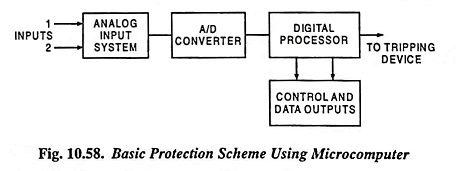Microprocessor Based Digital Relay:
With the fast development in large scale integrated (LSI) technology, sophisticated and fast microprocessors are now available. With the rapid growth of modern complex large power system networks, fast, accurate and reliable protective schemes are essential. Microprocessor Based Digital Relay schemes are becoming more and more popular for power system protection as they offer attractive compactness and flexibility. They reduce the number of types of relay units.
An interface employing op-amps, analog multiplexer analog-digital (A/D) converter, voltage comparators and passive elements have been developed to provide the characteristics of various types of relays such as definite time relays, inverse-time overcurrent relays, phase comparators and reverse power relays etc.
A block diagram of a microprocessor based digital programmable static relay is shown in Fig. 10.58.
The three-phase ac quantities received from the power system through CTs and PTs are sampled simultaneously or sequentially at uniform time intervals (4 to 32 samples per cycle). They are then converted into the digital form through an A/D converter and transferred to digital processor. Digital signals are in the form of coded square pulses which represent discrete data. The signals are in binary form. The microprocessor/digital processor being set with the recommended values compares the dynamic inputs and decides accordingly to generate trip/alarm signal to the output device.
Advantage of Microprocessor Based Digital Relay:
Microprocessor Based Digital Relay have numerous advantages. They have a very small burden on the CTs and PTs. Saturation can be avoided by using air-gap CT having a limited output. They can process and display the signals very efficiently, accurately and in a fastest possible manner. Due to their programmable characteristics, they can he applied extensively in the protection of electrical power systems. Moreover, one microprocessor unit may be able to perform relaying function of several systems.
Microprocessor relays are more reliable and secure to relay engineers because they can alert the user to a malfunction before a false trip or failure to trip occurs. However, the microprocessors should be properly shielded from external influences and the system earthing must be very good from which they receive their control voltage.
